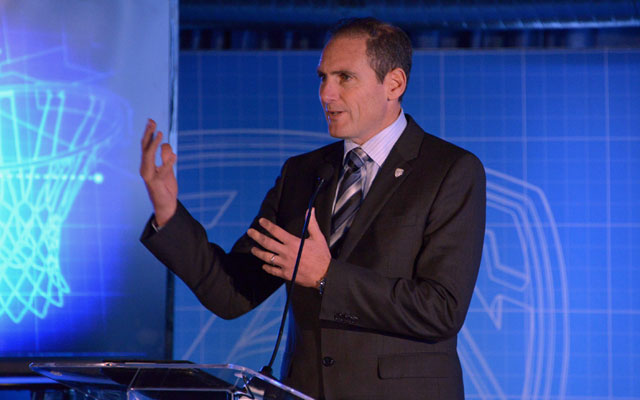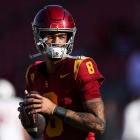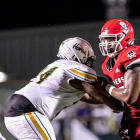
SAN FRANCISCO -- The Pac-12’s gorgeous, state-of-the-art offices in downtown San Francisco symbolize the financial state of the conference. The shared offices with the Pac-12 Network blend the league’s daily operations with the only television channel in major college sports that is owned entirely by a conference. They are joined at the hip.
Owning 100 percent of the channel’s equity gives the Pac-12 options in the future to further monetize some of its asset, assuming there are interested media partners in sharing ownership. Increasingly, some people within the Pac-12 are worried the SEC and Big Ten are about to significantly jump ahead of the Pac-12 in television money again.
“I think the worry five years from now, 10 years from now, is will there be a significant gap?” Pac-12 commissioner Larry Scott said this month at the conference’s spring meetings in Phoenix. “We don’t believe there will be. In some respects, we’re in a uniquely good situation in that we own and control our own network and have a lot of optionality in terms of what we can do down the road. I feel very comfortable with where we are, and I’m trying to educate and share some of that information with our ADs.”
The Pac-12 distributed 67 percent of its record $374 million of revenue to member schools in 2013-14, according to the conference’s IRS 990 form released Thursday to CBSSports.com. That was on part with 68 percent distribution in 2012-13.
By contrast, in 2013-14, the Big Ten returned 94 percent of revenues back to members, the SEC provided 90 percent to members, and the Big 12 distributed 87 percent to members. The ACC’s tax return from last year has not been released publicly yet, but it returned 91 percent to members in 2012-13.
“It’s a bit of apples and oranges,” Scott said in a March interview from the Pac-12 offices. “Because we own the network ourselves, we have to report all of the operations on the network. The Big Ten doesn’t report the revenues and expenses of the Big Ten Network because they’re a minority owner. The SEC Network, likewise. If you compare just our conference operations, it’s very comparable numbers.”
Scott, who has been the country’s highest-paid commissioner, was credited with $3.5 million in total compensation for 2013-14, up from $3.3 million and $3.1 million the prior two years. In the latest tax return, Scott had a base salary of $2,378,750 and received a $900,000 bonus. He continues to have an outstanding relocation loan of $1,861,842 from when he was hired.
Big 12 commissioner Bob Bowlsby made about $2.5 million in 2013-14. SEC commissioner Mike Slive earned $2.1 million, a 69-percent increase from the previous year. Big Ten commissioner Jim Delany had a base salary of $2.1 million, up about 65 percent, and was credited with nearly $3.4 million in total compensation. (The Big Ten’s tax return said about $830,000 was reported as deferred payment in previous years.)
The Pac-12 reported two other executives with total compensation nearing $1 million -- former Pac-12 Network president Gary Stevenson (almost $1.1 million) and current Pac-12 Network president Lydia Murphy-Stephans ($975,170). Eight other conference and network employees made more than $300,000, including then-deputy commissioner Kevin Weiberg ($646,396).
Every Pac-12 school except Utah ($16.1 million) received more than $21 million. The Pac-12’s 2013-14 revenue increased by $40 million to $374 million, keeping the conference ahead of the Big Ten ($338.9 million) and SEC ($325.9 million). The Pac-12 reported 2013-14 net assets at minus-$7.2 million, compared to minus-$8.3 million the year before.
Inevitably, some conferences jump ahead of one another depending on the market when TV deals get made. But there’s increasing concern by some people within the Pac-12 that it’s about to get passed again -- and in a major way.
How much money is enough for Pac-12 to keep pace?
As a business model, the Pac-12 isn’t the old Pac-10 anymore. Scott changed the equation. In recent years, the Pac-12 has obtained significantly more money from its TV deals, created shared revenue among the schools, and received better exposure on ESPN.
Shortly after Scott became commissioner after overseeing the Women’s Tennis Association, he nearly pulled off a financial game-changer by adding Texas and Oklahoma to the Pac-12.
“I’m not more of a look-back guy. I’m more of a look-forward guy,” Scott said. “But sitting here today, even though I was relatively new, I think the instincts were spot on. I think it would have been something very transformative and would have accelerated where I think college football is going anyway.”
Yes, the Pac-12 will always compete with pro sports and gorgeous weather for fan interest in football -- the major moneymaker in college sports -- compared to larger SEC and Big Ten fan bases. Of the 18 highest-rated college football games in the 2014 regular season, only one involved a Pac-12 team (USC vs. Stanford). The SEC played in 10 of those 18 games.
Yes, the Pac-12 has now gone the longest among Power Five conferences without a football national title (10 years and counting). A Pac-12 school other than USC hasn’t won a football national championship since Washington in 1991, even as Oregon gets close.
But the new money from the Pac-12’s $3 billion deal with ESPN and Fox through 2024 has helped buy and retain quality football coaches and improved facilities. Six Pac-12 football teams finished in the top 25 of the final Associated Press poll in 2014, tied with the SEC for the most.
“The level of depth and success we’ve had I think is pretty directly correlated to exposure and resources that have come from our media agreements,” Scott said.
Still, an alarm sounded around the Pac-12 in March when San Jose Mercury News reporter Jon Wilner wrote a series projecting the league’s financial future. Wilner’s conclusion: Even if the Pac-12 Network eventually gets distribution with DirecTV -- a never-ending saga that frustrates the Pac-12 and its fans -- the conference will soon lag far behind.
Wilner estimated that starting in 2017-18, TV revenue for conferences will look like this: SEC $35.6 million, Big Ten $33 million, Pac-12 $22.95 million. No Pac-12 athletic director who spoke with CBSSports.com would go on record about the topic. But several ADs privately shared concerns represented in Wilner’s series, especially as new costs for athletes kick in, such as cost of attendance and post-college medical expenses.
Pac-12 schools currently receive about $1 million each year from the Pac-12 Network. South Carolina athletic director Ray Tanner recently told his trustees that the new SEC Network, flush with leverage from ESPN/Disney as partners, could pay at least $5 million per school this year. The Big Ten Network pays out more than $10 million to each school annually and the conference has a new TV deal for Tier 1 rights coming in 2017-18.
Wilner’s numbers in the series “at least from our perspective were not completely accurate,” Scott told CBSSports.com in March. “But overall, I don’t disagree with the trends. I think the Big Ten is going to have a significant uptick in their rights knowing they’ll get more in 2017. And the SEC Network I believe is going to kick out significant resources. It’s a big, big success. What we haven’t shared with anyone was our projections for how our network is going to grow. The numbers that (Wilner) used and what he thinks it will be is nowhere near that.”
How consumers watch programming continues to quickly change. More people are cutting off their cable and using mobile and streaming devices to watch television. There could be a day when Apple and/or Google enter the world of owning live sports programming.
“One of the reasons I was attracted to (full ownership of the Pac-12 Network) is I feel like we’re in a very fast-changing dynamic world when it comes to the value of college sports rights, and changes in technology and distribution,” Scott said. “It’s happening before our eyes.”
Scott said the Pac-12 is not currently considering selling equity in the Pac-12 Network. He views the network’s value as being “significantly greater” five years from now.
“We very much like the position we’re in, and more importantly, feel like we’re in a growing market (for the value of college sports),” Scott said. “So as long as the market is still growing and increasing in value, it’s an enviable position to be in.”
Scott won’t speculate on how much he thinks the Pac-12 Network’s value has increased since the channel launched in 2012, but his answer suggests he’s willing to wait to find out. “I think we’ll be able to have a better read on the answer to that question when the Big Ten does their deal in the next two years,” he said.
Meshing Pac-12 Network with conference
The Pac-12 offices are flush with elaborate technology for the Pac-12 Network’s six regional and one national channels. The network hires more than 17,000 positions (about 2,500 individuals) to televise 850 events and 650 studio shows.
Pac-12 officials said media companies have visited the Pac-12 offices to learn how they transmit video through the pipeline of the Internet instead of via satellite. The Pac-12 Network received an Emmy nomination for technology.
Rather than produce many games from mobile units, the Pac-12 Network connects all of its schools together through the Internet so video goes back to San Francisco for the events to be produced. The method required significant and unspecified financial investments by Pac-12 schools. The approach saves the Pac-12 Network between $10,000 to $15,000 per show and $2.7 to $4.2 million a year, said Jonathan Leess, Pac-12 Network senior vice president of production planning and operations.
Pac-12 Network president Lydia Murphy-Stephans said the decision by conference presidents and chancellors to own the channel was a “very sophisticated” move longterm. Still, it’s an evolving process for everyone involved.
Murphy-Stephans worked 13 years for ABC Sports. That task was much simpler than today: Acquire rights from a rights holder, produce the event, and then leave. At the Pac-12 Network, “I’ve made more presentations and had more meetings in the past three years than I probably had in the last 25 years combined in the media business,” she said.
Murphy-Stephans meets with senior women’s administrators to discuss proposed schedules. She talks with faculty advisors about missed class time for players. She has even fielded phone calls from athletic directors complaining about Pac-12 Network announcers who wear a tie that’s perceived to be in favor of a certain team.
Mostly, Murphy-Stephans said she wants to be as transparent as possible to Pac-12 chancellors, presidents, athletic directors and coaches while educating them on what it takes to own and sustain a network.
“If the goal was short-term -- get as much money to the university athletic departments as possible -- they would have not opted for the model we currently have,” Murphy-Stephans said. “I don’t believe that was the goal. There’s a difference between asking a university athletic director what he or she would like and asking a university president what he or she would like.”
Will multimedia rights and China yield new revenue?
Where will the Pac-12 find new revenue? In the short-term, this could come from Pac-12 schools regaining their multimedia rights from third parties, such as IMG College and Learfield Sports, so the Pac-12 could manage those rights.
The Pac-12 began a six-month study examining the idea in March. Pac-12 schools were told pooling these rights in-house could make them about $2 million more each year, according to the Sports BusinessJournal. Pac-12 Properties reported $9.5 million in total income for 2013-14 through intellectual property rights, licensing and sponsorship sales. But it’s questionable whether pooling the rights would benefit high-profile schools such as USC and UCLA, who could make more money keeping their own rights.
“I think this represents a next logical step in terms of giving our schools more control over their destiny and retaining more of the value from their properties, but we haven’t come to a conclusion yet,” Scott said.
Meanwhile, Scott continues to push the Pac-12’s efforts to expand its brand into China. In November, Washington and Texas will play a regular-season men’s basketball game in China, where there are over 300 million basketball fans. The Pac-12 said it will become the first U.S. sports league to host a regular-season game in China.
The Pac-12 recently announced a two-year sponsorship with Alibaba Group, a major Chinese e-commerce company, for regular-season games in China. (Alibaba was sued last week in New York by luxury goods makers who allege the company knowingly made it possible for counterfeiters to sell their products throughout the world, according to Reuters. Alibaba said the complaint has “no basis.” The Pac-12 declined to comment on the lawsuit.)
Scott anticipates playing an annual Pac-12 tip-off game in China by rotating teams and including educational components for players. He declined to place a dollar value on what a game in China is worth to the Pac-12.
“I don’t really think of it in those terms right now,” Scott said. “Longterm, I think it’ll be more obvious in terms of what the value is.”
Pac-12 presidents view the West Coast as the gateway to the Pacific Rim to attract new students and collaborate on research. About five percent of the Pac-12’s student body comes from China, more than any other international country. The amount of Chinese students in the Pac-12 range from 2 percent (Washington State, Colorado, Arizona State) to 9 percent (USC, Washington).
Twenty-eight athletic administrators from leading Chinese universities attended the Pac-12 men’s basketball tournament in Las Vegas earlier this year. Unlike in America, Chinese students who compete in college sports aren’t the country’s elite athletes at their age. The best Chinese prospects for national teams or to turn pro go to sports academies.
“But China is very interested in learning about the US system and how we blend the best of both worlds,” Scott said.
In America, that often means capitalizing off major college sports brands. For now, the Pac-12 is juggling the risks and rewards of fully owning a TV network as the league waits to see how far it will financially fall behind the SEC and Big Ten.




















